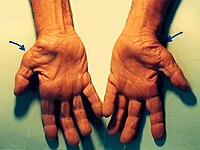
Photo from wikipedia
Objective: Finger flexion contractures are an important cause of disability in patients with systemic sclerosis; however, their pathophysiology is poorly understood. Our aim was to assess the feasibility of scanning… Click to show full abstract
Objective: Finger flexion contractures are an important cause of disability in patients with systemic sclerosis; however, their pathophysiology is poorly understood. Our aim was to assess the feasibility of scanning finger flexor tendons in patients with systemic sclerosis and explore the ultrasound findings in these tendons, including measurement of finger flexor tendon complex. Methods: Grey-scale and power Doppler ultrasound assessment of the finger flexor tendon complex including tendon structure and surrounding soft tissue. Measurements of the finger flexor tendon complex (A1 pulley, tendon and palmar plate) were made. Feasibility was assessed by the number of fingers which could be measured. Results: We studied the second to fifth flexor tendons (n = 160) of both hands in 20 patients with systemic sclerosis, including early and established disease. We were able to assess the finger flexor tendon complex and make measurements of the flexor tendon and palmar plate in all (n = 40) and A1 pulley in almost all (n = 39) of the studied fingers. Common pathologies identified included peritendinous (n = 12) and soft tissue (n = 8) calcification. Tendon thickening was seen in six patients, but synovitis/tenosynovitis was rare. The A1 pulley was thickened in patients with systemic sclerosis (0.46 mm), in particular, those with diffuse cutaneous systemic sclerosis (0.50 mm). Conclusion: We were able to successfully assess, including making measurements of, the finger flexor tendon complex in patients with systemic sclerosis. Our study showed calcifications in the peritendinous areas and soft tissue and thickening of the A1 pulley. These findings may play a role in the pathophysiology of systemic sclerosis–hand contractures by causing mechanical impingement of the finger flexion mechanism. This pilot study will guide future research to look for potential (treatable) causes of finger flexion contractures in patients with systemic sclerosis.
Journal Title: Journal of Scleroderma and Related Disorders
Year Published: 2019
Link to full text (if available)
Share on Social Media: Sign Up to like & get
recommendations!